![Aaron Douglas, Education of The Colored Man, WPA mural, Atlantic City Housing Project, Holmes Village, New Jersey, 1938 [now destroyed].jpg Aaron Douglas, Education of The Colored Man, WPA mural, Atlantic City Housing Project, Holmes Village, New Jersey, 1938 [now destroyed].jpg](https://486312.frmmmguz.asia/files/square_thumbnails/15f36a75369345850036ab75f68edbfe.jpg)
Education of the Colored Man
In 1938, Aaron Douglas returned to Fisk University as an assistant professor of Art Education, and it was during his summer there that he, under the aegis of the Treasury Department’s Treasury Relief Arts Projects, created the mural Education of the Colored Man, for the Atlantic City Holmes Village Housing Project in New Jersey. The mural depicts a young Frederick Douglass standing before a small crowd—a civil war solider, a former slave, a sharecropper and a seamstress—who listen to his words. Behind them is a growing metropolis, representing the industrial expansion of the urban north. The art project was funded by the Treasury Relief Arts Project (TRAP) and the Works Progress Administration (WPA).
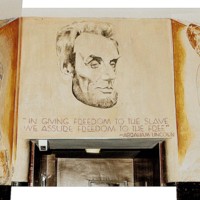
Seward Park Mural
In 1959 the Hungarian-American illustrator and muralist Hugo Gellert created the series Seward Park Housing Murals. The four-panel mural series depicts Thomas Jefferson, Abraham Lincoln, Franklin D. Roosevelt and Albert Einstein and was commissioned by the International Ladies Garment Workers Union. The Abraham Lincoln panel has an abolitionist section that features Frederick Douglass, John Brown, Harriet Tubman, Sojourner Truth and William Lloyd Garrison.The mural was threatened with destruction many times, including in 1996 when the building residents voted to become a private co-op. Individuals on the co-op board then voted to rid the lobby of the murals that they deemed racist, ugly, socialist or 'past their time.' But the building manager, Frank Durant, insisted on their preservation.
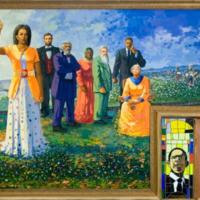
From Menelik I to Obama
Ethiopian artist Mekbib Gebertsadik put the abolitionist Frederick Douglass alongside President Lincoln, the abolitionist John Brown, Malcolm X, President Obama and Michelle Obama. Titling the mural From Menelik I to Obama, Gebertsadik also placeed Douglass on a timeline of diasporic history that starts with Menelik I, the first Solomonic Emperor of Ethiopia in 950 BC, to President Barack Obama, the first African American president. The mural is a few blocks away from the White House at the Gospel Rescue Ministries homeless shelter, acting as a symbol of hope for those passing through. “Primarily, the clients we serve are African American and [the mural is] an inspiration to our clients of being able to dream” explains Earl Murray, Associate Director for Development and Marketing for Gospel Rescue Ministries.
![Walter Edmonds & Richard Watson, Painting 7, Church of the Advocate [African American Episcopal Church], 1801 W. Diamond St, Philadelphia, 1974.jpg Walter Edmonds & Richard Watson, Painting 7, Church of the Advocate [African American Episcopal Church], 1801 W. Diamond St, Philadelphia, 1974.jpg](https://486312.frmmmguz.asia/files/square_thumbnails/e327c85c758c9839bb0746ded74d8668.jpg)
African American Experience
During the Civil Rights Movement, African American activists held rallies and conventions at the Church of the Advocate. But people started to notice the absence of black figures from the church artwork. Father Washington remembered: “there were people who came into the church, and as they looked around they saw nothing and no one, including the figures in the stained glass windows, with whom they could identify. Everything they looked at was white, white, white. ‘How can we look at this white image for our liberation when it is our experience that it is the white man who is our oppressor?’" Upon hearing these questions, Father Washington realised that “we could see the black experience revealed and defined in religious terms, and find parallel situations in what we read in the Old Testament every Sunday.” He commissioned a series of murals for the side of the church, painted by Walter Edmonds and Richard Watson, that show parallels between the experiences endured by Hebrew slaves in Egypt and those suffered by African slaves in America.
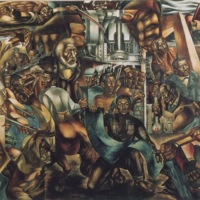
The Contribution of the Negro to Democracy in America
In 1941, the artist Charles White was awarded $2000 from the Julius Rosenwald Fellowship for an ambitious project that included the creation of Contribution of the Negro to Democracy in America. Two years later, he unveiled the mural at the Hampton Institute in Virginia.The central figure has chains around his wrists that also loop around the necks of three other figures. But the shackles on the figure’s wrists are ready to be broken by the abolitionists: Frederick Douglass, Nathaniel Turner, Denmark Vesey, Harriet Tubman and Peter Still.
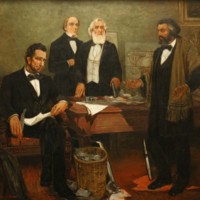
Frederick Douglass Appealing to President Lincoln
William Eduardo Scott completed this mural in 1943. The mural depicts a historical meeting during which the abolitionist Frederick Douglass advised President Lincoln to enlist black soldiers into the Union Army during the Civil War. A national competition was held for this mural commission, part of a series installed in the Recorder of the Deeds Building in Washington D.C. Artists were asked to depict episodes from African American history. Out of 300 applicants, seven were selected. Scott was the only African American artist. The subjects of the other panels were Crispus Attucks, Benjamin Banneker, the death of Colonel Shaw at Fort Wagner, slaves building bulwarks from cotton bales at the Battle of New Orleans, Cyrus Tiffany saving Commodore Perry’s life at the Battle of Lake Erie, and Matthew Henson planting the American flag at the North Pole.
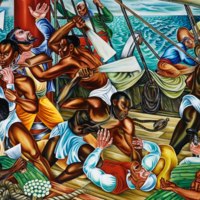
Amistad Murals
In 1938 the Talladega College President Buell Gallagher commissioned the muralist Hale Woodruff to paint a series of six murals about the transition from slavery to freedom. These murals were to be displayed in the Savery Library. Installed in 1939, on the centennial of the Amistad slave ship uprising, the first three mural panels depicted scenes of the mutiny: The Mutiny Aboard the Amistad (depicting the 53 Africans kidnapped from Sierra Leone to be sold into Spanish slave trade, and the uprising of Senbeh Pieh, also known as Cinque); The Trial of the Amistad Captives (depicting the first civil rights case in America) and The Repatriation of the Free Captives (depicting the repatriated slaves on the shores of Africa). The remaining three panels of the series are titled The Underground Railroad; Opening Day at Talladega College, and The Building of Savery Library. During an interview with Al Murray in 1968, Woodruff remembered: “Out of this mutiny people like Josiah Willard Gibbs, the Baldwins, Tappan and so forth, formed what was called the American Missionary Association (AMA). That was about 1840. It was out of the efforts of this organization that many of the Negro schools in the South were founded – LeMonye, Talladega, and so forth. So this mural was a gesture of appreciation on the part of Talladega for the AMA. The mural was also painted in honor of the slaves and their mutiny and their final freedom.”